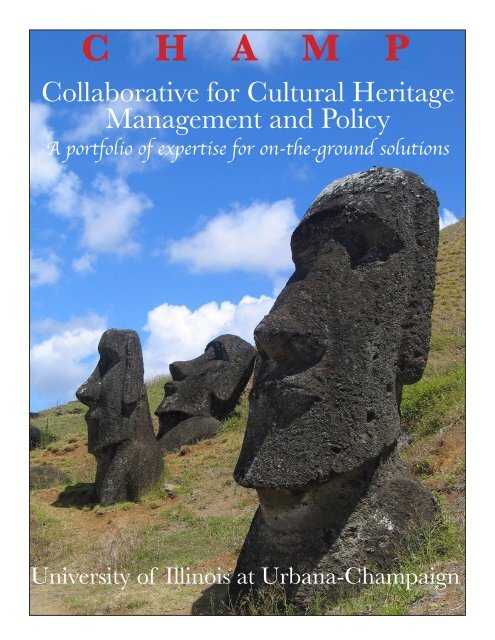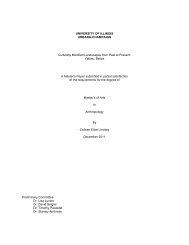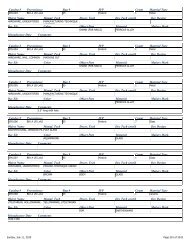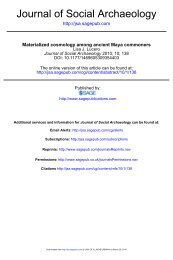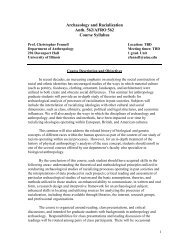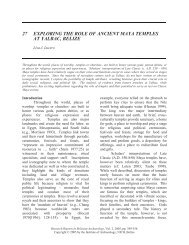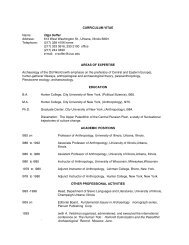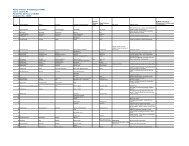CHAMP @ Illinois - University of Illinois at Urbana-Champaign
CHAMP @ Illinois - University of Illinois at Urbana-Champaign
CHAMP @ Illinois - University of Illinois at Urbana-Champaign
Create successful ePaper yourself
Turn your PDF publications into a flip-book with our unique Google optimized e-Paper software.
Greetings from the Director <strong>of</strong> <strong>CHAMP</strong>I’m Helaine Silverman, the Director <strong>of</strong> the Collabor<strong>at</strong>ive for Cultural HeritageManagment and Policy. Wh<strong>at</strong> a pleasure it is to write this introduction to <strong>CHAMP</strong>’s firstnewsletter (Summer 2013). Started in 2005, the Collabor<strong>at</strong>ive for Cultural HeritageManagement and Policy (<strong>CHAMP</strong>) has evolved into one <strong>of</strong> the premier research centersfor cultural heritage and museum studies. <strong>CHAMP</strong> is especially gr<strong>at</strong>eful to Pr<strong>of</strong>essor D.Fairchild Ruggles (former Co-Director <strong>of</strong> <strong>CHAMP</strong>), the Department <strong>of</strong> LandscapeArchitecture, Department <strong>of</strong> Anthropology, and the Center for Global Studies for theirsignificant contributions to the growth <strong>of</strong> <strong>CHAMP</strong> into its current configur<strong>at</strong>ion.The past year has been an especially good one for <strong>CHAMP</strong>. We had an array <strong>of</strong> guest speakers, becameinvolved in the cre<strong>at</strong>ion <strong>of</strong> the new UNESCO Center for Global Citizenship <strong>at</strong> <strong>Illinois</strong> (UCGC), learned muchfrom important projects being conducted around the world by <strong>CHAMP</strong> scholars, enjoyed the continuingwealth <strong>of</strong> faculty public<strong>at</strong>ions, and saw an enthusiastic cohort <strong>of</strong> gradu<strong>at</strong>e students pursuing minors inHeritage Studies and Museum Studies. The most exciting development this year has been the formaliz<strong>at</strong>ion <strong>of</strong><strong>CHAMP</strong>’s partnership with the outstanding Ironbridge Intern<strong>at</strong>ional Institute for Cultural Heritage (IIICH) <strong>at</strong>the <strong>University</strong> <strong>of</strong> Birmingham in the United Kingdom, led by its visionary director, Pr<strong>of</strong>essor Mike Robinson.<strong>CHAMP</strong> will build on these achievements to construct a yet more productive future. I welcome everyoneto join us in our many activities. Please visit <strong>CHAMP</strong>’s website to keep up with all news and events(champ.anthro.illinois.edu).Kind regards,Helaine SilvermanDirector <strong>of</strong> <strong>CHAMP</strong>2
<strong>CHAMP</strong> ON CAMPUS<strong>CHAMP</strong> co-sponsored the campus Distinguished Lecture <strong>of</strong> Dr. Michael Day (Chief Executive, HistoricRoyal Palaces, England) who spoke about major changes in the present<strong>at</strong>ion <strong>of</strong> Kensington Palace to thepublic (April 25, 2013).<strong>CHAMP</strong> became a founding partner <strong>of</strong> the new UNESCO Center for Global Citizenship (UCGC).Cur<strong>at</strong>or Allyson Purpura reinstalled the Africa Gallery in the Krannert Art Museum (see photo).<strong>CHAMP</strong> and IIICH (Ironbridge Intern<strong>at</strong>ional Institute for Cultural Heritage) co-hosted the workshop,“Encounters with Popular Pasts: Meanings and Myths <strong>at</strong> the Interface Between Heritage & Popular Culture,”on the UIUC campus. Fifteen colleagues from the <strong>University</strong> <strong>of</strong> Birmingham, UIUC, and five other Americanuniversities presented a fascin<strong>at</strong>ing series <strong>of</strong> papers, which we plan to publish.<strong>CHAMP</strong>’s Newest Faculty Member:Christine Taitano DeLisleTina is an historian <strong>of</strong> the Pacific Islands, U.S. Empire, and N<strong>at</strong>ive Pacificwomen and gender. She is Chamorro and has a special interest in her homeisland <strong>of</strong> Guam and Micronesia. Prior to coming to UIUC, Tina taught <strong>at</strong> the<strong>University</strong> <strong>of</strong> Michigan, where she was a postdoctoral fellow in the Asian/Pacific Islander American Studies Program. She also has taught MuseumStudies and Pacific Island History courses <strong>at</strong> the <strong>University</strong> <strong>of</strong> Guam. OnGuam, Tina has been involved in various public history projects. These includeco-producing a film (with Vicente Diaz, UIUC Department <strong>of</strong> Anthropology)on traditional Micronesian seafaring and navig<strong>at</strong>ion and a film onpre-World War II Chamorro p<strong>at</strong>tera (“nurse-midwives”). She also hascur<strong>at</strong>ed several exhibits on Guam and Micronesia such as the recent “I Kel<strong>at</strong>/The Fence: Historical Perspectives on Guam’s Changing Landscape,” whichis the Guam component <strong>of</strong> the Smithsonian’s “Between Fences” exhibit.Tina’s museum experience also includes assisting the Chicago Field Museum with the display and use byChicago communities <strong>of</strong> a traditional nineteenth-century Maori whare nui (“meeting house”) and she servesas a consultant to the new Guam Museum. Recently, Tina was invited to address the U.S. military buildup inGuam by the Guam Humanities Council in their community “civic reflection” convers<strong>at</strong>ions and by the<strong>University</strong> <strong>of</strong> Guam as part <strong>of</strong> its Presidential Lecture series.4
TRAINING IN HERITAGE STUDIES, MUSEUMSTUDIES, AND ARCHITECTURAL STUDIES<strong>CHAMP</strong> sponsors two interdisciplinary gradu<strong>at</strong>e minors (Heritage Studies; Museum Studies) in addition tothe MSc in Architectural Studies with a concentr<strong>at</strong>ion in historic preserv<strong>at</strong>ion, which is housed in UIUC’sSchool <strong>of</strong> Architecture. Currently, students pursuing these minors come from:- Anthropology- Architecture- Landscape Architecture- Library and Inform<strong>at</strong>ion Science- Recre<strong>at</strong>ion, Sport and Tourism- Urban and Regional PlanningFound<strong>at</strong>ional courses include:- Case Studies in Global Heritage (World Heritage Studies)- Cultural Heritage- Cultural Aspects <strong>of</strong> Tourism- Heritage Management- Historic Building Preserv<strong>at</strong>ion- History <strong>of</strong> the Urban Environment- History <strong>of</strong> World Landscapes- Museum Inform<strong>at</strong>ics- Museum Theory and Practice- Recording Historic Buildings- Social Construction <strong>of</strong> SpaceMore than a dozen other courses are <strong>of</strong>fered as topical electives. Heritage Studies students have theopportunity to work <strong>at</strong> sites around the world, including recurring projects in the U.S., Peru, and India. MuseumStudies students have internships in the campus museums and museums elsewhere as well as learningfrom study visits to major museums in nearby Chicago, Indianapolis and St. Louis. Students particip<strong>at</strong>e instudy tours to World Heritage and other ancient and historic sites and noteworthy urban centers. Under the<strong>CHAMP</strong>-IIICH collabor<strong>at</strong>ion students from <strong>Illinois</strong> and from Birmingham will be able to study <strong>at</strong> eachother’s campuses and take seminars based on jointly prepared course modules.5
Trans-Atlantic Dialogues onCultural Heritage (TADCH)Mike and Helaine have chosen the concept <strong>of</strong> “Trans-Atlantic Dialogues on Cultural Heritage” (TADCH)as the intellectual framework for the <strong>CHAMP</strong>-IIICH rel<strong>at</strong>ionship. Our aim is, by reflection and discussion,to gener<strong>at</strong>e a series <strong>of</strong> research questions th<strong>at</strong> examine Old World and New World perspectives on culturalheritage. We propose a genuine two-way explor<strong>at</strong>ion <strong>of</strong> the continuities and disturbances in the ways th<strong>at</strong>heritage is constructed, consumed, medi<strong>at</strong>ed and filtered. Similar yet different, the powerful and influentialintellectual traditions <strong>of</strong> North America and Europe are linked through historical engagement and contemporaryeveryday connection. Each side <strong>of</strong> the Atlantic – North as well as South – <strong>of</strong>fers its own geographicaland historical specificity expressed and projected through heritage. In geopolitical terms and through everydaymobilities, people, objects and ideas have flowed and continue to flow back and forth across the Atlantic,each shaping the heritage <strong>of</strong> the other and each shaping the meanings and values th<strong>at</strong> heritage conveys.TADCH asks: Where, and in wh<strong>at</strong> ways are these Trans-Atlantic heritages connected? Where, and in wh<strong>at</strong>ways are they not? Wh<strong>at</strong> can we learn from reflecting on the different contexts and cultures as they produce,consume, absorb, resist, and experience the heritage <strong>of</strong> the other? Trans-Atlantic dialogues on cultural heritage– which began as early as the voyages <strong>of</strong> Christopher Columbus and Leif Ericcson – are deeply implic<strong>at</strong>edin an important array <strong>of</strong> approaches to modernity and its future.The first event <strong>of</strong> the TADCH initi<strong>at</strong>ive was the May 23-24, 2013 workshop on heritage and popular culture(see page 9), which inaugur<strong>at</strong>ed wh<strong>at</strong> will be a series <strong>of</strong> open-ended and provoc<strong>at</strong>ive conferences th<strong>at</strong> areintended to significantly advance the empirical study and theoriz<strong>at</strong>ion <strong>of</strong> cultural heritage. StrengtheningTADCH is the timely award <strong>of</strong> a prestigious Fulbright Grant to <strong>CHAMP</strong>’s Associ<strong>at</strong>e Director, Paul H. Kapp(School <strong>of</strong> Architecture), with which he will spend Spring 2014 <strong>at</strong> IIICH. Also, Helaine has been named aVisiting Research Fellow <strong>at</strong> IIICH for 2013-2015, and Mike will be a Research Associ<strong>at</strong>e <strong>at</strong> UIUC.8
<strong>CHAMP</strong> Partners with the UNESCOCenter for Global Citizenship <strong>at</strong> <strong>Illinois</strong><strong>CHAMP</strong> director Helaine Silverman, Pr<strong>of</strong>essor Barbara Ford (Gradu<strong>at</strong>e School <strong>of</strong> Library and Inform<strong>at</strong>ionScience, UIUC and a member <strong>of</strong> the United St<strong>at</strong>es N<strong>at</strong>ional Commission for UNESCO) and Pr<strong>of</strong>essor AmaniAyad (Gradu<strong>at</strong>e School <strong>of</strong> Library and Inform<strong>at</strong>ion Science, UIUC) are the co-founders <strong>of</strong> UCGC.The desire to cre<strong>at</strong>e this organiz<strong>at</strong>ion sprang from our commitment to key ideals <strong>of</strong> UNESCO by advancingintercultural engagement, assisting in the form<strong>at</strong>ion <strong>of</strong> inclusive knowledge societies and promoting sustainabledevelopment. UCGC was inaugur<strong>at</strong>ed on April 15, 2013 in a ceremony <strong>of</strong>fici<strong>at</strong>ed by Mr. Guy Djoken,Executive Director <strong>of</strong> the UNESCO Center for Peace in Washington, D.C. In his keynote address,Mr. Djoken spoke about “UNESCO and the Mission for Peace in a Troubled World.” In his second lectureon April 16, Mr. Djoken talked about “Community Activism and UNESCO’s Millennial Goals.”At the inaugur<strong>at</strong>ion <strong>of</strong> UCGCFrom left to right: Elly Hanauer (Associ<strong>at</strong>e Director, Center for Global Studies, UIUC), Barbara Ford,Don Gerard (Mayor <strong>of</strong> the City <strong>of</strong> <strong>Champaign</strong>, IL), Guy Djoken, Laurel Prussing (Mayor <strong>of</strong> the City <strong>of</strong><strong>Urbana</strong>, IL), Helaine Silverman, and Amani Ayad10
A Selection <strong>of</strong> <strong>CHAMP</strong> Faculty ProjectsAndrew Bauer (Anthropology)discourses <strong>of</strong> n<strong>at</strong>ural heritage in IndiaDonna Buchanan (School <strong>of</strong> Music)ethnomusicology and cultural heritage in the BalkansAnita Say Chan (College <strong>of</strong> Media)globaliz<strong>at</strong>ion and digital cultures in PeruLaura Davis (Anthropology)coal and the heritage <strong>of</strong> labor and class in <strong>Illinois</strong>Christina Taitano DeLisle (American Indian Studies)public history and the represent<strong>at</strong>ion <strong>of</strong> identity on GuamLynne Dearborn (Architecture)the Hmong vernacular environment in Thailand and the U.S.Chris Fennell (Anthropology)historical archaeology <strong>of</strong> heritage and identity in IrelandSusan Frankenberg (Anthropology)hyphen<strong>at</strong>ed heritage and community museums in the U.S. midwestElly Hanauer (Center for Global Studies)interpreting immigr<strong>at</strong>ion in French museumsPaul Kapp (Architecture)urban regener<strong>at</strong>ion and historic preserv<strong>at</strong>ion in the U.S. and EnglandCele Otnes (Business Administr<strong>at</strong>ion)consuming royal heritage in EnglandRobert Pahre (Political Science)American heritage in the U.S. n<strong>at</strong>ional parksAllyson Purpura (Krannert Art Museum)representing Africa in the museumCarla Santos (Recre<strong>at</strong>ion, Sport and Tourism)cultural capitals <strong>of</strong> Europe and mass-medi<strong>at</strong>ed tourism narr<strong>at</strong>ivesHelaine Silverman (Anthropology)UNESCO World Heritage and community sustainability in Peru and ThailandAmita Sinha (Landscape Architecture)sacred Hindu landscapes <strong>of</strong> IndiaGabriel Solis (School <strong>of</strong> Music)mid-20th century nostalgia and the cre<strong>at</strong>ion <strong>of</strong> heritage from pop culture in the U.S.Michael Twidale (Library and Inform<strong>at</strong>ion Science)museum inform<strong>at</strong>ics and digital heritage11
Books by <strong>CHAMP</strong> Faculty12
Gradu<strong>at</strong>e Student Spotlight:Caroline WislerWe are happy to fe<strong>at</strong>ure the research <strong>of</strong> one <strong>of</strong> <strong>CHAMP</strong>’s fine gradu<strong>at</strong>e students,Caroline Wisler, who is working toward her doctor<strong>at</strong>e in the Department<strong>of</strong> Landscape Architecture. Caroline is the Gradu<strong>at</strong>e Student Liaisonto <strong>CHAMP</strong>’s Executive Committee. She has compiled a record <strong>of</strong> outstandingtraining for a future heritage career. Caroline holds a BA in Archaeologyand Religious Studies, an MA in Landscape Archaeology and a secondMA in Anthropology. Prior to beginning doctoral studies <strong>at</strong> UIUC, Carolinespent a Fulbright year in Banja Luka, Bosnia and Herzegovina, where sheconducted independent research and was a lecturer <strong>at</strong> the <strong>University</strong> <strong>of</strong>Banja Luka. Most recently, Caroline was awarded a prestigious ResearchFellowship with the American Research Center (ARCS) loc<strong>at</strong>ed in S<strong>of</strong>ia,Bulgaria for a semester <strong>of</strong> cultural immersion in the history <strong>of</strong> the Balkanswhile conducting research on heritage development in post-communistsocieties and studying the Serbo-Cro<strong>at</strong>ian language. She was the recipient <strong>of</strong> FLAS Fellowships forAcademic Years 2012-13 and 2013-14 through UIUC’s Russian, Eastern European, and Eurasian Center andEuropean Union Center, respectively. This summer she returns to Bulgaria for an archaeological fieldseason with ARCS <strong>at</strong> Heraclea Sintica. In the following (necessarily brief) st<strong>at</strong>ement Caroline tells us abouther doctoral research.It was compelling events – such as the shelling <strong>of</strong> the old city <strong>of</strong> Dubrovnik in 1991, the demolition <strong>of</strong> theBamiyan Buddhas <strong>of</strong> Afghanistan in 2001, and the destruction <strong>of</strong> the Askari mosque in Samarra, Iraq in2006 and 2007– coupled with my interest in how cultural heritage can be activ<strong>at</strong>ed to serve local communitiesth<strong>at</strong> urged me toward my current research. I seek an applied understanding <strong>of</strong> the practice, politics andpolicymaking <strong>of</strong> cultural landscape reconstruction and heritage management in post-conflict or transitioningsocieties with the critical purpose <strong>of</strong> fostering mutual understanding and coexistence. My regional focus isthe former eastern bloc and Yugoslavia. I have a particular interest in Bosnia and Herzegovina (BiH), whichsuffered extreme violence during its transition from st<strong>at</strong>e socialism to democracy in the early 1990s, the legacy<strong>of</strong> which is still seen and felt in the country. In BiH, nearly 3,000 architectural heritage properties werestr<strong>at</strong>egically targeted for destruction. Despite the signing <strong>of</strong> the Dayton Peace Accords in 1995, antagonismand tensions among ethnic groups continues to be exerted sp<strong>at</strong>ially in the landscape. Drawing upon theoreticalconstructs from Peace Studies, I identify these manipul<strong>at</strong>ions as structural and cultural violence, contributingto neg<strong>at</strong>ive peace in BiH and countries mired in intractable conflict. I explore the potential for culturalheritage – once instrumentalized for violent ends – to instead transform conflict. By repurposing heritageas a tool for public reconcili<strong>at</strong>ion, I propose th<strong>at</strong> inter-group dialogue can be facilit<strong>at</strong>ed through communityinvolvement in the reconstruction process. This process lends itself to the simultaneous development <strong>of</strong>a shared narr<strong>at</strong>ive to which groups contribute and identify through physical reconstruction. In this way, thecultural landscape can be both restored and re-storied. By activ<strong>at</strong>ing this l<strong>at</strong>ent capacity <strong>of</strong> cultural heritage,heritage pr<strong>of</strong>essionals may increase the social sustainability <strong>of</strong> heritage by fostering communities’ understanding<strong>of</strong> and investment in their cultural heritage, regardless <strong>of</strong> its potential for representing difference.Communities divided as a result <strong>of</strong> conflict or those experiencing a period <strong>of</strong> tumultuous transition may alternot only the current and future conditions <strong>of</strong> cultural heritage, but their society as a whole.14
“The French Connection”UIUC-École du Louvre ExchangeIn the summer <strong>of</strong> 2012, the <strong>University</strong> <strong>of</strong> <strong>Illinois</strong> <strong>at</strong> <strong>Urbana</strong>-<strong>Champaign</strong> and the École du Louvre inParis signed a Memorandum <strong>of</strong> Understanding to develop a collabor<strong>at</strong>ive exchange program. The programhas two principal components:1) A summer study-abroad course for fifteen students from the <strong>University</strong> <strong>of</strong> <strong>Illinois</strong> and fivestudents from the École du Louvre.2) Two internships annually (one per semester) for gradu<strong>at</strong>e students from the École du Louvre<strong>at</strong> either the Spurlock Museum or the Krannert Art Museum.The study-abroad course meets for three weeks in July <strong>at</strong> various museums in and around Paris, and inthe classrooms <strong>of</strong> the École du Louvre. The course provides an introduction to museology and is taught byleading cur<strong>at</strong>ors, administr<strong>at</strong>ors, and other museum pr<strong>of</strong>essionals. Students also particip<strong>at</strong>e in discussions, ledby a pr<strong>of</strong>essor from the <strong>University</strong> <strong>of</strong> <strong>Illinois</strong>, in which they discuss the sessions with experts and the assignedreading. Students are graded by the pr<strong>of</strong>essor based on particip<strong>at</strong>ion and written assignments.Interns for the École du Louvre work <strong>at</strong> the museums <strong>of</strong> the <strong>University</strong> <strong>of</strong> <strong>Illinois</strong> on projects rel<strong>at</strong>ed totheir areas <strong>of</strong> specialty. Each internship lasts for one semester. Interns also <strong>at</strong>tend a gradu<strong>at</strong>e seminar in arthistory.The collabor<strong>at</strong>ion with the École du Louvre provides unique opportunities:- Access to monuments and art works. Sessions take place in galleries and other facilities normallynot open to students or the public. For example, last summer students entered the restor<strong>at</strong>ion studios<strong>of</strong> the Musée du Louvre and saw works by Giotto, Leonardo, Titian, Manet, and many others beingrestored. The restor<strong>at</strong>ion process was explained by demonstr<strong>at</strong>ions with masterpieces such asLeonardo’s St. Anne. For another example, <strong>at</strong> the ch<strong>at</strong>eau de Versailles students climbed up on scaffoldingto study ceiling frescoes. Other museums visits included the Musée d’Orsay, the Musée du QuaiBranly, and the Musée du Cluny.- World-class experts. Instructors included Pierre Curie, perhaps the gre<strong>at</strong>est living conserv<strong>at</strong>or <strong>of</strong>Renaissance painting, Laurence des Cars, head <strong>of</strong> Agence France-Muséums (which overseas an annualbudget <strong>of</strong> over €85 million), and renowned cur<strong>at</strong>ors such as Aurélien Gaborit and Christophe Léribault.All instructors play major roles in French museums.- Interaction between French and American students. American and French students study side by side.Museum policies vary enormously between the two countries and reflect fundamental differences inthinking about the st<strong>at</strong>e’s rel<strong>at</strong>ionship to citizens and n<strong>at</strong>ional heritage. In discussion session therehave been excellent deb<strong>at</strong>es between students th<strong>at</strong> opened their eyes to altern<strong>at</strong>ive ways <strong>of</strong> thinkingabout fundamental issues. For example, this past year students deb<strong>at</strong>ed policies concerning objectsacquired through colonialism or conquest, and they discussed whether museums should tre<strong>at</strong> all visitorsas identical, or recognize and address specific aspects <strong>of</strong> identity such as race, gender, and sexuality.The collabor<strong>at</strong>ion holds enormous potential for future development.- A new dimension to both undergradu<strong>at</strong>e and gradu<strong>at</strong>e curricula, providing opportunities for learningth<strong>at</strong> are not possible on campus.- A recruitment tool to <strong>at</strong>tract gradu<strong>at</strong>e students.- Publicity for the university th<strong>at</strong> demonstr<strong>at</strong>es its partnership with a museum and institution <strong>of</strong> higherlearning whose fame and achievements are unparalleled in their field.- Potential for future collabor<strong>at</strong>ive research projects for faculty and gradu<strong>at</strong>e students.15
<strong>CHAMP</strong>’s Executive CommitteeHelaine Silverman (Director) (helaine@illinois.edu)Paul Kapp (Associ<strong>at</strong>e Director) (phkapp@illinois.edu)Anita Chan (Media & Cinema Studies)Lynne Dearborn (Architecture)Susan Frankenberg (Museum Studies & Anthropology)David O’Brien (Art History)Cele Otnes (Business Administr<strong>at</strong>ion)Robert Pahre (Political Science)Wayne Pitard (Spurlock Museum)Allyson Purpura (Krannert Art Museum)Carla Santos (Recre<strong>at</strong>ion, Sport and Tourism)Amita Sinha (Landscape Architecture)Gabriel Solis (Music)Mike Twidale (Library and Inform<strong>at</strong>ion Science)Contact Us:Collabor<strong>at</strong>ive for Cultural Heritage Management and Policy109 Davenport Hall<strong>University</strong> <strong>of</strong> <strong>Illinois</strong> <strong>at</strong> <strong>Urbana</strong>-<strong>Champaign</strong>607 S M<strong>at</strong>thews Avenue<strong>Urbana</strong>, IL 61801USATel: (217) 333-3616Fax: (217) 244-3490Email: helaine@illinois.eduWebsite: champ.anthro.illinois.edu<strong>CHAMP</strong> Newsletter No. 1 (Summer 2013)Designed by Charlene Dudley (cjdudle2@illinois.edu)


